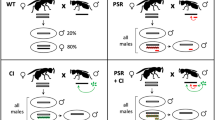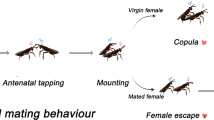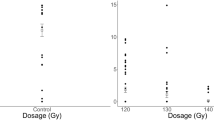Abstract
Autoparasitoid wasps lay fertilized (female) eggs in homopteran nymphs and unfertilized (male) eggs in immature parasitoids, often in females of their own species. Autoparasitoid host relationships are generally obligate; a male egg will not develop in the homopteran host even if laid there. While sex is controlled by the female by selective fertilization of eggs, the sex ratio is constrained by the availability of the appropriate hosts. However, in a population of the autoparasitoid Encarsia pergandiella in Ithaca, NY, some of the males develop, like females, as primary parasitoids of whiteflies. A cytogenetic examination of eggs laid in whiteflies revealed that these ‘primary’ males are haploid, but develop from fertilized eggs. Following fertilization, one set of chromosomes becomes overcondensed and is lost, thus converting the fertilized (female) egg into a haploid (male) egg. Genetic analysis suggests that the production of primary males is heritable; males that develop from parasitoid hosts do not produce primary sons, whereas primary males do. However, the transmission and/or expression of the primary male trait is low and variable. Only about 50 per cent of primary male matings result in any primary sons, and only about 28 per cent of all offspring produced on whiteflies are male. X-irradiation of primary males had no effect on the number of primary sons produced but greatly reduced the number of daughters, suggesting that it is the paternal genome that is lost in the production of primary males. Paternal inheritance of genome loss has been described in one other parasitic wasp, Nasonia vitripennis (Walker). There, chromosome loss is caused by a supernumerary chromosome (PSR). A supernumerary chromosome was not observed in the primary male E. pergandiella. It is unknown how widespread primary male production is among populations of E. pergandiella and other autoparasitoids.
Similar content being viewed by others

Article PDF
References
Baldanza, F, Gaudio, L, and Viggiani, G. 1991. Ricerche cariologiche sull'Archenomus orientalis Silvestri (Hymenoptera: Aphelinidae), parassitoide di Pseudaulacapis pentagona (Targioni Tozzeti) (Homoptera: Diaspididae). Atti XVI Congresso nazionale italiano di Entomologia Bari —Martina Franca (Ta) 23/28 settembre 1991, 457–461.
Breeuwer, J A J, and Werren, J H. 1990. Microorganisms associated with chromosome destruction and reproductive isolation between two insect species. Nature, 346, 558–560.
Crozier, R H. 1977. Evolutionary genetics of the Hymenoptera. Ann Rev Entomol, 22, 263–268.
Gerling, D. 1966. Studies with whitefly parasites of Southern California. I. Encarsia pergandiella Howard (Hymenoptera: Aphelinidae). Can Entomol, 98, 707–724.
Goodpasture, C. 1975. Comparative courtship behavior and karyology in Monodontomerus (Hymenoptera: Tory-midae). Ann Entomol Soc Am, 68, 391–397.
Goodpasture, C, and Grissell, E E. 1975. A karyological study of nine species of Torymus (Hymenoptera: Torymidae). Can J Genet Cytoi, 17, 413–422.
Hung, A C F. 1986. Chromosomes of three Brachymeria species (Hymenoptera: Chalcididae). Experientia, 42, 579–580.
Hunter, M S. 1991. Sex ratio in an autoparasitoid Encarsia pergandiella Howard (Hymenoptera: Aphelinidae). PhD Thesis, Cornell University, Ithaca, NY.
Nur, U, Werren, J H, Eickbush, D G, Burke, W D, and Eickbush, T H. 1988. A ‘selfish‘ B chromosome that enhances its transmission by eliminating the paternal genome. Science, 240, 512–514.
Rössler, Y, and Debach, P. 1973. Genetic variability in a thelytokous form of Aphytis mytilaspidis (Le Baron) (Hymenoptera: Aphelinidae). Hilgardia, 42, 149–175.
Ryan, S L, and Saul, II G B. 1968. Post-fertilization effect of incompatibility factors in Mormoniella. Mol Gen Genet, 103, 29–36.
Skinner, S. 1982. Maternally inherited sex ratio in the para-sitoid wasp Nasonia vitripennis. Science, 215, 1133–1134.
Skinner, S. 1986. Paternal transmission of an extrachromosomal factor in a wasp: evolutionary implications. Heredity, 59, 47–53.
Stouthamer, R, Luck, R F, and Hamilton, W D. 1990. Anti-biotics cause parthenogenetic Trichogramma (Hymenoptera: Trichogrammatidae) to revert to sex. Proc Natl Acad Sci, USA, 87, 2424–2427.
Strand, M R, and Ode, P J. 1990. Chromosome number of the polyembryonic parasitoid Copidosoma floridanum (Hymenoptera: Encyrtidae). Ann Entomol Soc Am, 83, 834–837.
Vet, L E M, and Van Lenteren, J C. 1981. The parasite-host relationship between Encarsia formosa Gah. (Hymenoptera: Aphelinidae) and Trialeurodes vaporariorum (Westw.) (Homoptera: Aleyrodidae).X. A comparison of three Encarsia spp. and one Eretmocerus sp. to estimate their potentialities in controlling whitefly on tomatoes in greenhouses with a low temperature regime. Z Ang Ent, 91, 327–348.
Viggiani, G. 1967. Richerche sugli Hymenoptera Chalcioidea.XV. Osservazioni cariolgiche preliminari sulli Aphelinus mali. Boll Lab Entomol Agr ‘Filippo Silvestri’ Portici, 25, 326–330.
Waage, J K. 1986. Family planning in parasitoids: Adaptive patterns of progeny and sex allocation. In: Waage, J. K. and Greathead, D. (eds) Insect Parasitoids, Academic Press, Boston, pp. 63–95.
Walter, G H. 1983. 'Divergent male ontogenies' in Aphelinidae (Hymenoptera: Chalcidoidea): A simplified classification and a suggested evolutionary sequence. Biol J Linn Soc, 19, 63–82.
Walter, G H. 1988. Heteronomous host relationships in aphelinids — evolutionary pathways and adaptive significance (Hymenoptera: Chalcidoidea). Ad Para Hymenoptera Res, 1988, 313–326.
Werren, J H. 1987a. Labile sex ratios in wasps and bees. Bio Sci, 37, 498–506.
Werren, J H. 1987b. The coevolution of autosomal and cytoplasmic sex ratio factors. J Theor Biol, 124, 317–334.
Werren, J H. 1991. The paternal-sex-ratio chromosome of Nasonia. Am Nat, 137, 392–402.
Werren, J H, Nur, U, and Eickbush, D. 1987. An extrachromosomal factor causing loss of paternal chromosomes. Nature, 327, 75–76.
Werren, J H, Nur, U, and Wu, C I. 1988. Selfish genetic elements. TREE, 3, 297–302.
Werren, J H, Skinner, S W, and Charnov, E L. 1981. Paternal inheritance of a daughterless sex ratio factor. Nature, 293, 467–468.
Werren, J H, Skinner, S W, and Huger, A M. 1986. Male-killing bacteria in a parasitic wasp. Science, 231, 990–992.
Author information
Authors and Affiliations
Rights and permissions
About this article
Cite this article
Hunter, M., Nur, U. & Werren, J. Origin of males by genome loss in an autoparasitoid wasp. Heredity 70, 162–171 (1993). https://doi.org/10.1038/hdy.1993.25
Received:
Issue date:
DOI: https://doi.org/10.1038/hdy.1993.25
Keywords
This article is cited by
-
Mechanistically comparing reproductive manipulations caused by selfish chromosomes and bacterial symbionts
Heredity (2021)
-
Feminization and the collapse of haplodiploidy in an asexual parasitoid wasp harboring the bacterial symbiont Cardinium
Heredity (2009)
-
Single locus complementary sex determination in Hymenoptera: an "unintelligent" design?
Frontiers in Zoology (2006)
-
Germ cell development in the Honeybee (Apis mellifera); Vasa and Nanosexpression
BMC Developmental Biology (2006)
-
Sex determination and inbreeding depression in an ant with regular sib-mating
Heredity (2006)


